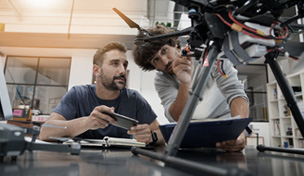Keywords: Sustainable Manufacturing, Manufacturing
Market Overview
Protonic ceramic fuel cells, one of the most promising energy conversion devices, suffer significant manufacturing challenges at both high and low temperatures. Compared with conventional methods, direct laser 3D printing (DL3DP) can avoid furnace firing, miniaturize the manufacturing space by one hundred times, and decrease the manufacturing time by 150 times down to minutes while only consuming 10% of processing electricity. The newly developed DL3DP method is characteristic of digital layer deposition (i.e., 40 precise and controllable thickness by combining micro extrusion and spray-coating) and selective laser processing (i.e., laser drying, firing, and machining), allowing the complete manufacturing of PCFCs without high-temperature and long-time furnace firing steps. The grain-boundary-free and surface-defect-free thin dense electrolytes, nanoporous electrodes, and well-bonded interfaces ensure high performance. Overall, this method can rapidly manufacture multilayer, multi-material, and multifunctional ceramic/metal composite structures for a wide range of next-generation energy conversion and storage devices, including fuel cells, electrolyzers, and solid-state batteries.
Applications:
Energy conversion and storage devices (fuel cells, electrolyzers, and solid-state batteries)
Technical Summary:
The thin dense GBF electrolyte, the highly porous anode with nickel nanoparticles, and the nanoporous cathode achieved by optimizing DL3DP conditions guaranteed the high performance and long-term stability of the PCFC cells and stacks. The cells show peak power densities 1.6-2.6 times that of the conventionally processed control samples. The stacks demonstrate peak power of 7 W and constant power outputs of 0.5-3.1 W for 110-260 hours, proving practical feasibility. Furthermore, PCFCs obtain unprecedentedly high area-independent power densities around 830 mW/cm2 at 650˚C and perform competitively at 1.8 times that of state-of-the-art solid oxide fuel cells.
Advantages:
- Miniaturize PCFC manufacturing space to mobile refrigerator size, 100 times smaller than conventional methods.
- 150 times faster than tape-casting/furnace-firing-based methods.
- High performance and long-term stability of PCFC cells and stacks.
- Unprecedently high area-independent performance for PCFs.
- Only requires 10% of typical processing electricity.
Technology Overview
State of Development
Available for licensing
Category
CURF Reference No.
2023-016
Inventors
Dr. Joshua Tong
For More Info, Contact:
Mark Roth, Associate Director of Business Development
E: mroth3@clemson.edu
P: 864.656.4935
Contact
Latest News from CURF
Stay up-to-date with the latest trends in the innovation and research industry. Sign up for our newsletter to see how CURF is making a difference and impacting the economy where we live.









